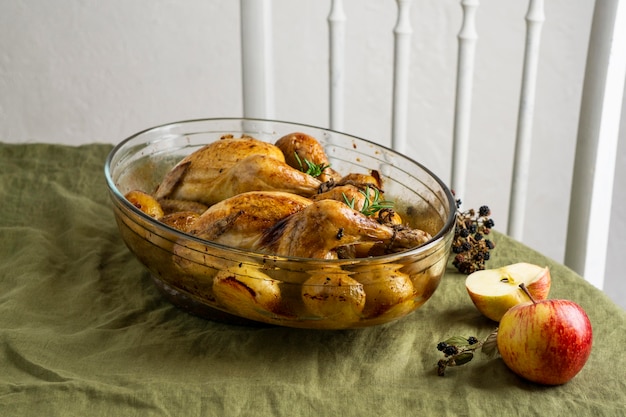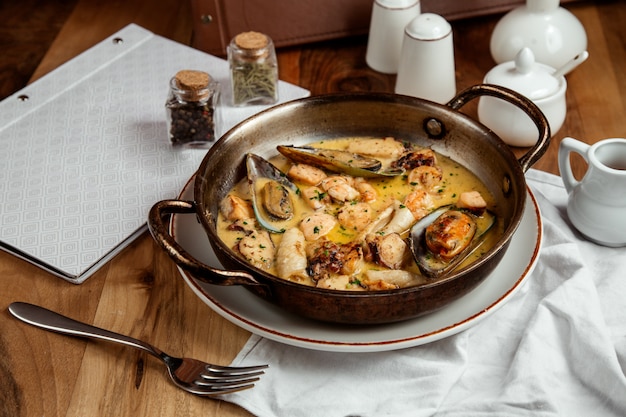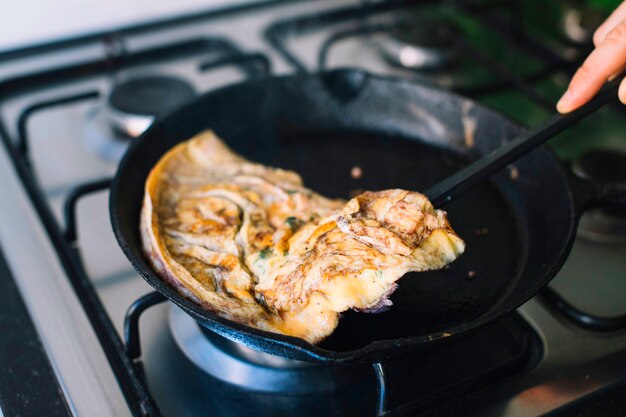I've always loved pot roast. It's a dish that evokes memories of cozy evenings, warm smells filling the house, and the comforting feeling of a hearty, home-cooked meal. My mum used to make it all the time, and it was one of those dishes that felt like a warm hug on a cold day. It's also a dish that gets better the longer it cooks, and the slow cooker is the perfect appliance for achieving that melt-in-your-mouth tenderness. The slow cooker allows the meat to cook low and slow, breaking down the connective tissue and resulting in a juicy, flavorful roast. Plus, it allows you to add a variety of vegetables and flavour combinations, making it a truly versatile dish.
Over the years, I've experimented with countless recipes and techniques, and I've learned a lot about achieving the perfect pot roast. In this article, I'm going to share all my secrets - from choosing the best cuts of meat to mastering the perfect time and temperature for a slow-cooked masterpiece. So, grab your slow cooker and get ready to become a pot roast pro!
Part 1: The Meat - choosing the right cut for Tenderness and Flavor

The foundation of any good pot roast lies in the cut of meat. Not all cuts are created equal, and some are simply better suited for slow cooking than others. When selecting a cut for your pot roast, you'll want to look for a cut that's naturally tough and contains plenty of connective tissue. These tough cuts are the perfect candidates for slow cooking, as the gentle heat will break down that connective tissue, resulting in tender, flavorful meat. Here are some of the most popular cuts for pot roast, each with its unique characteristics:
1. chuck roast: A Classic Choice
Chuck roast is the classic choice for pot roast, and for good reason! It's a very tough cut, but that's precisely what makes it perfect for slow cooking. The high amount of connective tissue breaks down beautifully in the slow cooker, yielding incredibly tender meat with rich, deep flavor. Plus, it's usually very affordable, making it a budget-friendly option.
2. Shoulder Roast: A Close Cousin to Chuck
Shoulder roast is very similar to chuck roast in terms of texture and flavour. It's another tough, flavorful cut that benefits tremendously from slow cooking. In fact, when referring to the pork shoulder, it's often called "boston butt," highlighting its richness and deliciousness.
3. bottom round roast: The Lean Option
Bottom round roast is a leaner cut than chuck or shoulder, meaning it has less fat and connective tissue. It's still a good choice for pot roast, but it's important to cook it slowly and carefully to prevent it from drying out. The key is to make sure it's cooked to the right temperature and to add enough liquid to keep it moist.
Part 2: Preparing the Meat - Getting Ready for the Slow Cooker

Once you've chosen your perfect cut of meat, it's time to prepare it for slow cooking. I like to trim off any excess fat, as this can make the pot roast greasy and detract from the flavour. You can also score the meat with a knife to help it cook more evenly. This simple technique involves making shallow cuts into the surface of the meat. These cuts allow the seasonings to penetrate deeper, resulting in more evenly cooked meat with a beautiful crust. Just be gentle when scoring, as you don't want to make deep cuts, which can lead to tough, dry meat.
Now, it's time to season the meat! I usually start with salt and pepper, then add garlic powder, onion powder, and paprika for a base flavour profile. You can use a dry rub, or simply season the meat with your favourite herbs and spices. If you're feeling adventurous, try a blend of cumin, coriander, paprika, and chili powder for a more complex flavour. Remember, the seasoning is key to building a rich, flavorful pot roast!
Part 3: The Vegetables - Adding Flavor and Texture

While the meat is the star of the show, the vegetables are the supporting actors, adding complexity and texture to the dish. You can use just about any vegetables you like in your pot roast, but some of my favourites include:
- Carrots: Carrots add a touch of sweetness and vibrant colour to the pot roast, while softening beautifully during the slow cooking process.
- Potatoes: Potatoes provide a hearty and satisfying texture, and they soak up the delicious flavours of the sauce.
- Onions: Onions add depth and complexity to the dish, creating a rich base flavour that complements the meat beautifully.
- Celery: Celery adds a crispness and refreshing taste that contrasts nicely with the richness of the meat.
- Mushrooms: Mushrooms contribute a rich, earthy flavour that adds another dimension to the dish.
You can add the vegetables directly to the slow cooker with the meat, or add them later in the cooking process, depending on the texture you desire. I typically add the carrots and potatoes at the beginning, as they need more time to soften. The onions and celery I add about halfway through the cooking process, ensuring that they remain crisp and not overcooked.
Part 4: The Liquid - Creating a Delicious Sauce
The liquid in your pot roast is just as important as the meat and vegetables. It helps to create a rich and flavorful sauce, and it also keeps the meat moist. There are many different liquids you can use, but here are some of the most common and delicious options:
- beef broth: The classic choice for pot roast, beef broth adds a rich, savory flavour to the dish, complementing the meat beautifully.
- Red Wine: Red wine adds a depth of flavour and a hint of sweetness to the pot roast. If you're using red wine, deglazing the pot after browning the meat will create a truly delicious sauce.
- Water: A simple and straightforward option, water will keep the meat moist and prevent it from drying out.
- Tomato Juice: Tomato juice adds a tangy and acidic flavour to the pot roast, creating a unique and vibrant taste.
No matter what liquid you choose, make sure you use enough to cover the meat and vegetables. For a slow cooker with a capacity of 6 quarts or less, you'll probably need about 2 cups of liquid. For a larger slow cooker, you'll need more.
Part 5: The Time and Temperature - The Slow Cooker Magic
Now, we get to the heart of slow-cooking magic! The right time and temperature will transform your pot roast from a tough cut of meat into a tender and delicious masterpiece.
Setting the Temperature
You'll want to set your slow cooker to low and cook for 6-8 hours, or high and cook for 4-6 hours. This slow and gentle cooking process will break down the connective tissue in the meat, resulting in incredibly tender results. The low setting is perfect for a long, leisurely cook, while the high setting is ideal if you need a faster meal. Always start on low, and increase the setting to high if needed. The most important thing is to ensure the meat is cooked through and reaches an internal temperature of 145°F (63°C) to kill any harmful bacteria.
Monitoring the Cooking Process
While the pot roast is cooking, check on it every few hours to make sure everything is going smoothly. You can also add more liquid if needed. The pot roast should be bubbling gently throughout the cooking process. If the liquid starts to evaporate too quickly, add more broth or water to keep the meat submerged. You can also check the meat for tenderness by using a fork or a skewer. The meat should easily shred when you pierce it.
Part 6: The Sauce - The Perfect Finishing Touch
The sauce is the finishing touch that brings the entire pot roast together. It's the culmination of all the flavors, creating a rich and flavorful sauce that you can pour over the meat and vegetables.
Making the Sauce
When the meat is finished cooking, remove it from the slow cooker and shred it with two forks. Let the sauce simmer in the slow cooker for an additional 15-20 minutes to thicken. You can also strain the sauce through a fine-mesh sieve to remove any fat or solids.
Thickening the Sauce
If you want a thicker sauce, you can add a cornstarch slurry. A cornstarch slurry is simply a mixture of cornstarch and cold water. To make a cornstarch slurry, mix 1 tablespoon of cornstarch with 2 tablespoons of cold water. Stir until the cornstarch is fully dissolved. Then, slowly whisk the cornstarch slurry into the sauce. Bring the sauce to a simmer and cook for a few minutes until the sauce has thickened.
You can also add a tablespoon of butter to the sauce to make it richer and smoother. It’s best to add the butter after the sauce has thickened, as this will prevent the butter from separating.
Part 7: Serving - A Symphony of Flavors
Once the pot roast is cooked and shredded, it's time to enjoy the fruits of your labor! I love serving my pot roast with mashed potatoes, steamed vegetables, and a side of gravy. Of course, you can serve it with any sides you like, but here are some ideas that pair perfectly with a delicious pot roast:
- Mashed Potatoes: Classic comfort food that goes great with pot roast. You can also add some roasted garlic or herbs to the mashed potatoes for extra flavour.
- Steamed Vegetables: A healthy and delicious way to round out your meal. Try steaming broccoli, green beans, or carrots. You can also add some butter or herbs to the vegetables for extra flavour.
- Gravy: Make a simple gravy using the juices from the pot roast. Just whisk in some cornstarch or flour to thicken the sauce.
- Rice: A simple and versatile side that goes well with pot roast. You can also try different types of rice, such as brown rice, wild rice, or jasmine rice.
- Bread: A perfect way to soak up the delicious sauce from the pot roast.
Part 8: Variations - Exploring Flavour Possibilities
While a classic pot roast is always a winner, there are endless possibilities to spice things up and explore different flavor profiles. Here are a few of my favourite variations, inspired by cuisines from around the world.
1. Italian Pot Roast: A Taste of Tuscany
For an Italian twist, try adding a few slices of prosciutto to the slow cooker along with the meat. You can also add some Italian seasoning and a splash of red wine to the sauce. For an extra touch of authenticity, include some diced tomatoes and onions to the slow cooker, allowing them to meld with the flavors during the cooking process.
2. Mexican Pot Roast: A Fiesta of Flavor
For a taste of Mexico, add some chili powder, cumin, and oregano to the pot roast. You can also add some diced tomatoes, onions, and peppers to the slow cooker. To make it even more authentic, try incorporating some chipotle peppers in adobo sauce for a smoky, spicy kick.
3. Asian-Inspired Pot Roast: A Fusion of Flavors
For an Asian-inspired flavour, add some soy sauce, ginger, garlic, and sesame oil to the pot roast. You can also add some sliced mushrooms and onions to the slow cooker. To make it even more flavorful, try marinating the meat in a mixture of soy sauce, ginger, garlic, and sesame oil for a few hours before cooking. This will infuse the meat with deep, complex flavors.
4. French Pot Roast: A Touch of Elegance
For a French pot roast, try adding some Dijon mustard, thyme, and rosemary to the meat. You can also add some diced carrots and onions to the slow cooker. For a luxurious touch, try serving the pot roast with a side of creamy mashed potatoes and a red wine reduction sauce.
Don't be afraid to experiment with different flavour combinations and spices to find your own signature pot roast recipe. The possibilities are endless!
Part 9: Tips and Tricks - Mastering the Art of Slow Cooking
Here are some extra tips and tricks that will help you elevate your pot roast game and create a truly unforgettable meal.
1. Browning the Meat: Building a Flavorful Crust
While it isn't necessary to brown the meat, it does add a richer flavour and a beautiful, crispy crust. You can brown the meat in a skillet or oven before adding it to the slow cooker. If you decide to brown the meat, make sure you sear all sides of the meat. This will create a flavorful crust and prevent the meat from becoming dry.
2. Deglazing the Pot: Extra Flavor from the Browned Bits
After browning the meat, deglaze the pot by adding a little bit of red wine or broth to the pan. Scrape up all the browned bits from the bottom of the pan and stir them into the sauce. This will add another layer of flavour to the pot roast, making it even more delicious.
3. Adding Acid: Tenderizing and Enriching Flavors
Adding a little bit of acid to the slow cooker can help to break down the tough connective tissue in the meat, making it more tender. You can add a splash of red wine, lemon juice, or tomato juice to the slow cooker. The acid will also help to enhance the flavor of the meat and vegetables.
4. Using a Slow Cooker Liner: Effortless Cleanup
A slow cooker liner is a lifesaver when it comes to cleanup. Simply place the liner in your slow cooker before adding the ingredients. When the cooking is finished, lift the liner out of the slow cooker and discard it, leaving your slow cooker sparkling clean!
5. Making Ahead: Enjoying the Benefits of Planning
One of the best things about pot roast is that it can be made ahead of time. You can cook the pot roast in the slow cooker the day before you want to serve it. Then, simply store the pot roast in the refrigerator and reheat it the next day. This makes pot roast a perfect dish for busy weeknights or weekend gatherings.
FAQs: Answering Your Pot Roast Questions
1. Can I make pot roast in the oven?
Yes, you can make pot roast in the oven. However, it will take a little longer to cook. To make pot roast in the oven, preheat your oven to 325°F (163°C). Place the meat in a roasting pan and add the vegetables and liquid. Cover the roasting pan with foil and bake for 3-4 hours, or until the meat is tender.
2. How do I know when the pot roast is done?
The best way to know when the pot roast is done is to use a meat thermometer. The internal temperature of the pot roast should reach 145°F (63°C) to ensure it is cooked through. You can also check the meat for tenderness by using a fork or a skewer. The meat should easily shred when you pierce it.
3. What if the pot roast is too dry?
If the pot roast is too dry, you can add some more liquid to the slow cooker. You can also try adding a tablespoon of butter to the sauce. This will help to make the sauce richer and smoother. If the pot roast is too salty, you can try adding some more liquid to the slow cooker. You can also try serving the pot roast with a side of mashed potatoes or rice to help soak up some of the salt.
4. Can I freeze pot roast?
Yes, you can freeze pot roast. To freeze pot roast, let it cool completely. Then, transfer the pot roast to a freezer-safe container or wrap it tightly in plastic wrap. Freeze for up to 3 months. When you are ready to eat the pot roast, thaw it in the refrigerator overnight. You can also thaw the pot roast in the microwave.
5. What are some other things I can do with leftover pot roast?
There are many things you can do with leftover pot roast. You can use it to make pot roast sandwiches, pot roast tacos, or pot roast soup. You can also add leftover pot roast to a salad or pasta dish.
With its versatility, deliciousness, and ease of preparation, pot roast is a true comfort food classic. So, embrace the magic of slow cooking, experiment with flavors, and create your own perfect pot roast masterpiece!
Everyone is watching

Prime Rib Roast Cooking Time Chart: Per Pound Guide
Cooking TipsPrime rib roast. Just the name conjures images of lavish dinners, crackling fires, and hearty laughter. It’s ...

How Long to Bake Potatoes in the Oven (Perfect Every Time)
Cooking TipsBaked potatoes are a staple in my kitchen. They're incredibly versatile, delicious, and surprisingly easy to m...

Perfect Rice Every Time: The Ultimate Guide to Cooking Rice
Cooking TipsAs a self-proclaimed foodie, I've always been a bit obsessed with rice. It's the foundation of countless cuisi...

The Ultimate Guide to Cooking Asparagus: Tips, Techniques, and Recipes
Cooking TipsAsparagus. The mere mention of this spring delicacy conjures up images of vibrant green spears, crisp and burs...

Ultimate Guide to Cooking the Perfect Thanksgiving Turkey
Cooking TipsThanksgiving. Just the word conjures up images of overflowing tables laden with delicious food, the scent of r...
